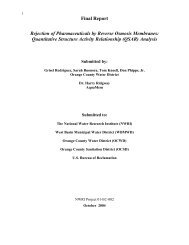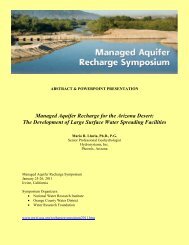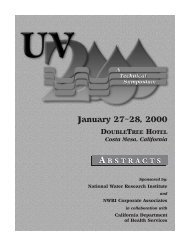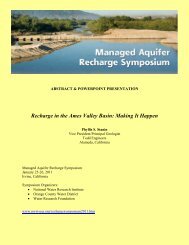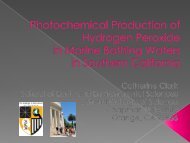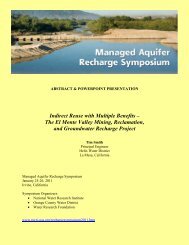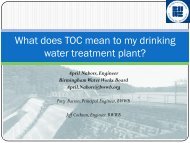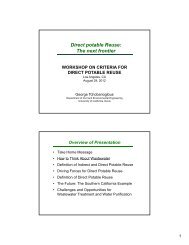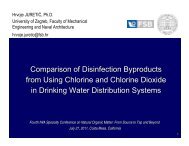RBF_Cover (for eps) - National Water Research Institute
RBF_Cover (for eps) - National Water Research Institute
RBF_Cover (for eps) - National Water Research Institute
You also want an ePaper? Increase the reach of your titles
YUMPU automatically turns print PDFs into web optimized ePapers that Google loves.
30<br />
The Cedar River and its water quality have been the subject of extensive studies and monitoring<br />
by the Cedar Rapids <strong>Water</strong> Department, USGS, Iowa Geological Survey Bureau, and other local<br />
agencies. These studies have documented several major water-quality issues that affect the river’s<br />
suitability <strong>for</strong> the three designation uses established by the Iowa Department of Natural Resources:<br />
• Primary contact recreation (e.g., swimming).<br />
• Wildlife, fish, and aquatic life.<br />
• Potable water source.<br />
<strong>Water</strong>-quality challenges come from both point and non-point sources and include excessive soil<br />
erosion/sedimentation, elevated levels of nitrate and phosphorous, and fecal coli<strong>for</strong>m bacteria<br />
counts above the acceptable levels <strong>for</strong> recreational swimming. The 57-mile segment of the Cedar<br />
River upstream from the City’s well field to LaPorte City has been placed on the State’s list of<br />
impaired streams due to elevated levels of nitrate and fecal coli<strong>for</strong>m bacteria.<br />
The most daunting challenge <strong>for</strong> the Cedar Rapids <strong>Water</strong> Department is the increasing trend of<br />
elevated levels of nitrate, especially in the spring and early summer. During these periods, monthly<br />
nitrate levels are routinely in the range of 10.0 to 14.7 mg/L as nitrogen (N). The drinking-water<br />
standard <strong>for</strong> nitrate is 10.0 mg/L (as N), and a single exceedance constitutes a violation.<br />
Fortunately, as illustrated in Figure 1, a 2- to 3-mg/L reduction in nitrate levels is generally<br />
accomplished as the water moves from the river to the wells. This natural reduction, combined<br />
with the monitoring and management of individual wells, has enabled the Cedar Rapids <strong>Water</strong><br />
Department to avoid any violations of the drinking-water standard <strong>for</strong> nitrate.<br />
16.0<br />
14.0<br />
12.0<br />
10.0<br />
8.0<br />
6.0<br />
4.0<br />
2.0<br />
0.0<br />
Jan-02<br />
Feb-02<br />
Mar-02<br />
Apr-02<br />
May-02<br />
Jun-02<br />
Monthly Nitrate Results (mg/L as N)<br />
Highest Reported Values<br />
Jul-02<br />
Aug-02<br />
Sep-02<br />
Oct-02<br />
Nov-02<br />
Dec-02<br />
Jan-03<br />
Feb-03<br />
Mar-03<br />
Apr-03<br />
May-03<br />
Jun-03<br />
Jul-03<br />
Cedar River<br />
NW <strong>Water</strong> Plant<br />
MCL Standard<br />
Figure 1. Highest recorded nitrate levels: Cedar River as compared to the well water supplies to Cedar<br />
Rapids’ NW <strong>Water</strong> Plant (Source: Cedar Rapids <strong>Water</strong> Department).<br />
Prior to 1963, the City of Cedar Rapids obtained its water supplies directly from the Cedar River.<br />
River water underwent treatment processes similar to those used today — lime softening,<br />
disinfection by chloramination, filtration, and the addition of fluoride and phosphate <strong>for</strong> corrosion<br />
control. This provided <strong>for</strong> safe drinking water, but failed to avoid the intermittent aesthetic<br />
problems (taste and odor) primarily associated with elevated algae levels in the river. This<br />
prompted the City to construct and convert its water supplies to a series of shallow wells along the<br />
Cedar River.



